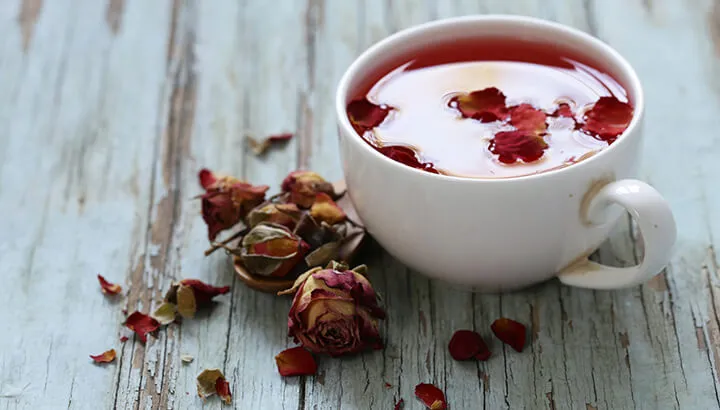I have always loved roses. The way they look, the way they smell, the soft texture of their petals… everything. My mother adored roses as well. She had a green thumb, and planted rose bushes to adorn the entrance of my childhood home. While I did not fully inherit the green thumb, I did inherit her appreciation of these ancient, beautiful flowers.
The smell of roses is so sweetly intoxicating that many may have wondered what they would taste like. Well, you should have a taste for yourself! Did you know that tea made from rose petals is not only delicious, but also incredibly healthy? Since ancient times, people have been drinking rose water and rose tea to remedy a wide array of ailments, including depression, digestive troubles and menstrual pain.
It turns out that many of these ancient uses are just as valid today as they were centuries ago. The following are seven benefits of rose petal tea (also sometimes called rose bud tea) and reasons to enjoy some of those fragrant petals in your teacup.
A great source of vitamin C
Rose petal tea is high in vitamin C, that all-important antioxidant vitamin that helps to kick your immune system into high gear. This makes it a great beverage to sip during cold and flu season, and whenever you’re feeling under the weather. On top of helping to ward off illnesses, vitamin C is also important for the health of your skin, hair and much more.
Antioxidant richness

Vitamin C isn’t the only antioxidant found in rose petal tea. This subtly flavored, fragrant tea also contains a wealth of polyphenol antioxidants (including anthocyanins), as well as ellagic acid and quercetin. All of these antioxidants help to fight free radical damage in the body, and can also help lower chronic inflammation, a major underlying factor in a number of chronic illnesses.
A 2006 study published in the journal Food Science assessed different varieties of rose petal tea for antioxidant content. After the analysis, the study authors summarized,“It was concluded that dried rose petals may be used for preparing antioxidant-rich caffeine-free beverages, either separately or in combination with other herbal materials.”
Delving deeper into the benefits of rose petal tea antioxidants, the authors of a 2013 study also published in Food Science wrote:
“As mutations are known to be the most important cause of the initiation of many diseases including cancer, phytochemicals exhibiting antimutagenic potential could be of immense significance. In the current study, rose cultivars having petals of different colors displayed a wide variation in their antimutagenicity against induced mutagenesis. The bioactive compound purified from the most potent rose cultivar was identified as an anthocyanin that could be of potential health benefits.”
Youthful appearance
The vitamin C and antioxidants found in rose petal tea can help you to look and feel younger. Vitamin C is important in the body’s production of collagen, which is a building block of skin, hair and more. Getting more vitamin C can thus encourage skin to look young and radiant as you age. The anti-inflammatory powers of this tea can also help you to look and feel your best by fighting oxidative stress throughout your body.
Mood boost
Rose petal tea has been enjoyed for centuries not only for its physical health benefits, but also for its uplifting and relaxing properties. Drinking a cup of this tea can help you to shake off a funk, and relax you when you are feeling tightly wound. Having a cup at night may also help to encourage deeper and more restful sleep.
Digestive support
If you suffer from frequent constipation, rose petal tea may help a lot. This tea has natural laxative properties, and can get things moving in your digestive system when they are feeling blocked up. Drinking this tea also helps stimulate bile production, which helps us to digest dietary fats more effectively.
Urinary tract health
Along with helping to ease constipation, rose petal tea also has natural diuretic properties. This means that it can encourage you to urinate more, thus keeping your urinary tract in optimal health. If you’re suffering from a mild urinary tract infection, drinking this tea may be significantly therapeutic. Of course, ask a health professional you trust before using a new herb for any health condition, just to be safe.
Menstrual symptom relief
One ancient use of rose petal tea is drinking it for the relief of menstrual cramps. In 2005, a study published in the Journal of Midwifery & Women’s Health tested the effects of this tea on 130 female teenagers with primary dysmenorrhea (abdominal cramping right before and during the menstrual cycle). On their results, the study authors wrote:
“The results showed that compared with the control group, the experimental group perceived less menstrual pain, distress and anxiety and showed greater psychophysiologic well-being through time, at one, three and six months after the interventions. Findings suggest that drinking rose tea is a safe, readily available, and simple treatment for dysmenorrhea, which female adolescents may take to suit their individual needs.”
How to make rose petal tea
First of all, make sure you get rose petals that have not been treated with any pesticides or herbicides. You can purchase dried rose buds or petals from a source you trust, or you can use fresh petals. If you are using fresh petals, cut off the white part at the bottom of the petals, as this part can make your tea bitter.
To make this tea using dried petals, heat a cup of water until it is just about ready to boil, then add a couple teaspoons of the rose petals. Steep for about three minutes. If you are making this tea with fresh rose petals, boil about three cups of water, then add about two cups of fresh rose petals. Simmer for about five minutes, then allow to cool to a drinkable temperature.
Have you ever tried rose petal tea? Please tell us about your experiences!
— Tanya Mead

